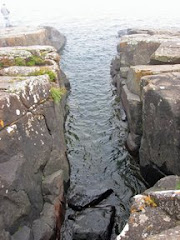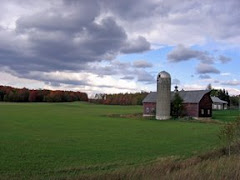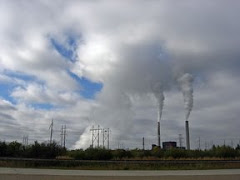While most of humanity places fresh water as a premium natural resource to be protected and used very wisely, Minnesota Democrats are engaged in the wanton destruction of the Big Bog in Northern Minnesota.
The Green Party remains silent in the face of this destruction and its candidate for governor omits any mention of what is taking place while Democratic Party stooges like Doris Marquit manipulates the Women's International League for Peace and Freedom here in Minnesota to evade discussion of what is taking place in the Big Bog while pretending to educate people on the threats to our water.
The League of Women Voters, always fronting for big-business interests and the DFL "Business Caucus," has refused to place any questions about peat mining in the Big Bog for candidates.
Here in Minnesota, the Minnesota Democratic Farmer-Labor Party (DFL) which is manipulated and controlled by big-business interests is engaged in destroying the largest freshwater aquifer in the Lower Forty-Eight by permitting peat mining to take place in the Big Bog.
Berger Peat, a multinational corporation out of Canada comprised of Canadian, U.S. and French "investors" who have made huge campaign contributions to United States Congressman James Oberstar and bribed the Minnesota Commissioner of Natural Resources and gave former Attorney General Mike Hatch expensive gifts along with making huge campaign contributions to Roger Moe, is now going to be requesting a permit to expand the peat mining from the original permit which allowed peat to be taken from a one-square mile area to over 14 square miles.
The reason for the expanded operation is that this peat will be used to clean up oil spills and once the peat soaks up the oil it will be used to fuel bio mass operations to generate electricity.
Roger Jourdain, the long-time former Chair of the Red Lake Nation described the Big Bog's freshwater aquifer as "the life-blood of my people and our Red Lake Nation." The present Red Lake Nation Tribal Council, whose primary interests are profiting from casinos and profiting from the drug trade, has refused to take action to save the Big Bog.
There has not been one peep of protest against this destruction of one of the world's last remaining pristine freshwater aquifers from "environmental organizations" like the Audubon Society or the Sierra Club.
After issuing the first permit which enabled Berger Peat to get its foot into the door and begin draining the bog so the peat can be mined here in Minnesota, the Minnesota Department of Natural Resources spent millions of dollars for a one-mile aluminum raised "Bog Walk" for tourist to understand the importance of this huge bog to the ecosystems!
Ironically, this Big Bog Boardwalk was raised at tremendous cost to tax-payers, some three feet off the ground, because "human footsteps would irreparably damage sensitive ecosystem of The Big Bog."
No wonder the Minnesota Supreme Court made its racist and undemocratic decision to deny the Warriors for Justice ballot status... saving the Big Bog and its very important ecosystems is one of their goals and objectives.
So far DFL candidate for governor Mark Dayton has refused to address the issue of saving and protecting the Big Bog.
Not one single scientist can be found to support peat mining in the Big Bog--- even the scientists employed by the Environmental Protection Agency and the United States Army Corps of Engineers came out in complete opposition to peat mining in the Big Bog. The heads of both agencies said they had their "arms twisted" by United States Congressman James Oberstar who threatened to use his powerful influence in Congress to cut funding to their programs if they did not issue permits. Oberstar is one of the most corrupt members of the United States Congress who has become fabulously wealthy taking bribes from the mining industries and road engineers and contractors--- so far, tax-payers have spent over twenty-million dollars building a road out into this pristine peat bog for Berger Peat and its investors to truck away the profits.
Other Democratic Party politicians who have reaped huge campaign contributions for supporting the destruction of the Big Bog include Rod Skoe, Brita Sailer, Mary Olson and John Persell. Dave Olin, the former prosecutor of Pennington County who publicly admits that he knew about the drug trade taking place for years in Red Lake Gaming Enterprises' three Seven Clans Casinos but did nothing to stop the drug trade, has received huge help in his campaign for re-election from the peat mining associations; this crooked and corrupt politician first took pay-offs from the drug dealers to allow their dirty, sleazy business to continue unhindered by law enforcement as he hypocritically prosecuted teenagers for using drugs these mobsters sold them, and now he is enabling the largest freshwater aquifer in the Lower Forty-Eight to be destroyed--- again, of course, for bribes. Democrat Dave Olin is the same politician who stood up in anger and lashed out against affirmative action--- now this racist slime-ball is receiving political and financial support, along with its endorsement, from the National Rifle Association.
United States Congressman James Oberstar boasted that this peat mining would create jobs in this economically depressed area where Marvin Windows and Doors, Polaris, Arctic Cat and casinos employ people at poverty wages; when asked by the news media how many jobs this operation was going to create for Minnesotans, Oberstar who is known for his great skills as an orator learned in over 40 years practicing deceit, hemmed and hawed and stuttered. His staff later said about thirty jobs would be created. When asked how much these jobs would pay they refused to comment. Months later it was announced that the jobs would be non-union per the agreement reached in then Attorney General Mike Hatch's office and the jobs would pay "up to $8.00 an hour. Berger Peat, operating out of Quebec, has said it has made arrangements through a Catholic church group to "help out some poor people from Ecuador to do most of the work on a seasonal basis."
Now, read this article and learn how stupid the big-business dominated, manipulated and controlled Minnesota Democratic Farmer-Labor Party and its willing accomplices are.
Alan L. Maki
29 September 2010 Last updated at 13:01 ET
By Richard Black Environment correspondent, BBC News
The study maps water availability and quality down to the regional level
About 80% of the world's population lives in areas where the fresh water supply is not secure, according to a new global analysis.
Researchers compiled a composite index of "water threats" that includes issues such as scarcity and pollution.
The most severe threat category encompasses 3.4 billion people.
Writing in the journal Nature, they say that in western countries, conserving water for people through reservoirs and dams works for people, but not nature.
They urge developing countries not to follow the same path.
"What we're able to outline is a planet-wide pattern of threat”
Instead, they say governments should invest in water management strategies that combine infrastructure with "natural" options such as safeguarding watersheds, wetlands and flood plains.
The analysis is a global snapshot, and the research team suggests more people are likely to encounter more severe stress on their water supply in the coming decades, as the climate changes and the human population continues to grow.
They have taken data on a variety of different threats, used models of threats where data is scarce, and used expert assessment to combine the various individual threats into a composite index.
The result is a map that plots the composite threat to human water security and to biodiversity in squares 50km by 50km (30 miles by 30 miles) across the world.
Changing pictures "What we've done is to take a very dispassionate look at the facts on the ground - what is going on with respect to humanity's water security and what the infrastructure that's been thrown at this problem does to the natural world," said study leader Charles Vorosmarty from the City College of New York.
"What we're able to outline is a planet-wide pattern of threat, despite the trillions of dollars worth of engineering palliatives that have totally reconfigured the threat landscape."
Those "trillions of dollars" are represented by the dams, canals, aqueducts, and pipelines that have been used throughout the developed world to safeguard drinking water supplies.
Their impact on the global picture is striking.
Natural
Looking at the "raw threats" to people's water security - the "natural" picture - much of western Europe and North America appears to be under high stress.
Managed
However, when the impact of the infrastructure that distributes and conserves water is added in - the "managed" picture - most of the serious threat disappears from these regions.
Africa, however, moves in the opposite direction.
"The problem is, we know that a large proportion of the world's population cannot afford these investments," said Peter McIntyre from the University of Wisconsin, another of the researchers involved.
"In fact we show them benefiting less than a billion people, so we're already excluding a large majority of the world's population," he told BBC News.
"But even in rich parts of the world, it's not a sensible way to proceed. We could continue to build more dams and exploit deeper and deeper aquifers; but even if you can afford it, it's not a cost-effective way of doing things."
According to this analysis, and others, the way water has been managed in the west has left a significant legacy of issues for nature.
Whereas Western Europe and the US emerge from this analysis with good scores on water stress facing their citizens, wildlife there that depends on water is much less secure, it concludes.
Concrete realities One concept advocated by development organisations nowadays is integrated water management, where the needs of all users are taken into account and where natural features are integrated with human engineering.
One widely-cited example concerns the watersheds that supply New York, in the Catskill Mountains and elsewhere around the city.
"We would argue people should be even more worried if you start to account for climate change and population growth"
Peter McIntyre University of Wisconsin
Water from these areas historically needed no filtering.
That threatened to change in the 1990s, due to agricultural pollution and other issues.
The city invested in a programme of land protection and conservation; this has maintained quality, and is calculated to have been cheaper than the alternative of building treatment works.
Mark Smith, head of the water programme at the International Union for the Conservation of Nature (IUCN) who was not involved in the current study, said this sort of approach was beginning to take hold in the developing world, though "the concrete and steel model remains the default".
"One example is the Barotse Floodplain in Zambia, where there was a proposal for draining the wetland and developing an irrigation scheme to replace the wetlands," he related.
"Some analysis was then done that showed the economic benefits of the irrigation scheme would have been less than the benefits currently delivered by the wetland in terms of fisheries, agriculture around the flood plain, water supply, water quality and so on.
"So it's not a question of saying 'No we don't need any concrete infrastructure' - what we need are portfolios of built infrastructure and natural environment that can address the needs of development, and the ecosystem needs of people and biodiversity."
Dollars short This analysis is likely to come in for some scrutiny, not least because it does contain an element of subjectivity in terms of how the various threats to water security are weighted and combined.
Developing countries are urged to think carefully about "concrete and steel" solutions
Nevertheless, Mark Smith hailed it as a "potentially powerful synthesis" of existing knowledge; while Gary Jones, chief executive of the eWater Co-operative Research Centre in Canberra, commented: "It's a very important and timely global analysis of the joint threats of declining water security for humans and biodiversity loss for rivers.
"This study, for the first time, brings all our knowledge together under one global model of water security and aquatic biodiversity loss."
For the team itself, it is a first attempt - a "placeholder", or baseline - and they anticipate improvements as more accurate data emerges, not least from regions such as Africa that are traditionally data-scarce.
Already, they say, it provides a powerful indicator that governments and international institutions need to take water issues more seriously.
For developed countries and the Bric group - Brazil, Russia, India and China - alone, "$800bn per year will be required by 2015 to cover investments in water infrastructure, a target likely to go unmet," they conclude.
For poorer countries, the outlook is considerably more bleak, they say.
"In reality this is a snapshot of the world about five or 10 years ago, because that's the data that's coming on line now," said Dr McIntyre.
"It's not about the future, but we would argue people should be even more worried if you start to account for climate change and population growth.
"Climate change is going to affect the amount of water that comes in as precipitation; and if you overlay that on an already stressed population, we're rolling the dice."
Richard.Black-INTERNET@bbc.co.uk















































































































